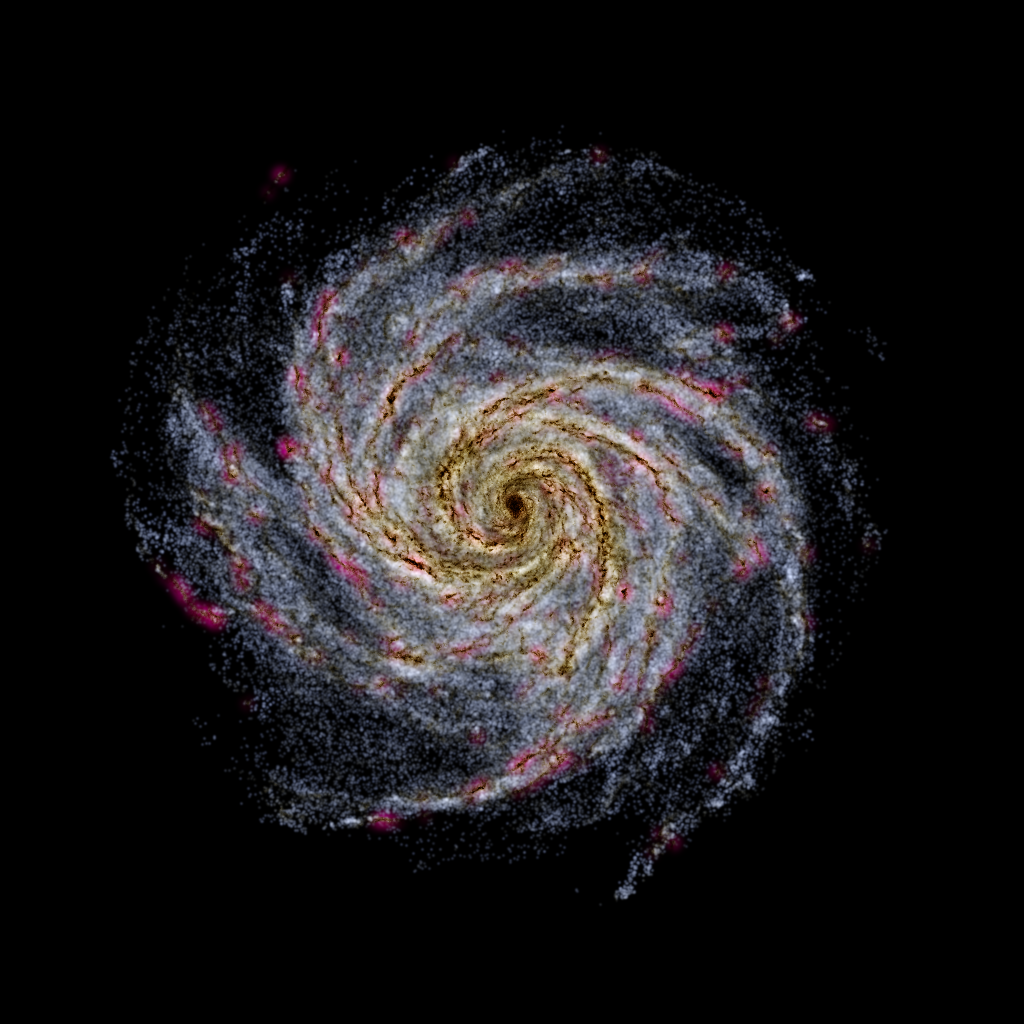Computing physical quantities¶
To run the examples proposed hereafter, you need first to follow the instructions given in the section Generate examples .
We also suppose that the following model has been loaded, i.e, in your python interpreter you typed:
>>> from pNbody import Nbody
>>> nb = Nbody("MW_galaxy.hdf5")
From brute arrays¶
Any array attached to an Nbody object contains physical quantities. They corresponds precisely to the values
stored in the snapshot without any conversion. In some cases working with those array can be useful. However, by
default, no units are attached to those arrays. They can be used the following way:
# coordinates of particles
>>> nb.pos
array([[ 0.59459096, -6.849886 , 0.83441144],
[ 1.1637805 , 9.026595 , 0.10752326],
[ 3.0834882 , -0.19680543, -0.28759104],
...,
[ 4.139927 , 1.5572525 , 0.14975849],
[-2.6131186 , -2.20977 , -0.05962646],
[-3.0051165 , -5.1332235 , 0.5773136 ]], dtype=float32)
# initial specific energy
>>> nb.u_init
array([1.0152912, 1.0152912, 1.0152912, ..., 0. , 0. ,
0. ], dtype=float32)
A large number of methods works directly on these brute arrays:
>>> nb.cm()
array([-0.3414196 , 0.1023279 , 0.59247654])
>>> nb.x()
array([ 0.59459096, 1.1637805 , 3.0834882 , ..., 4.139927 ,
-2.6131186 , -3.0051165 ], dtype=float32)
>>> nb.vx()
array([ 219.8732 , -206.42065 , 11.346481, ..., -13.726294,
111.58997 , 187.3271 ], dtype=float32)
By convention, the name of those methods stars with a lower case character.
With a proper conversion¶
If the Nbody object contains units or information if it comes from a cosmological simulation or not,
a proper conversion can be performed using methods.
By convention, the name of those methods stars with an upper case character.
Those methods can be supplemented with units.
How quantities are converted in different situations is described in section How to deal with comoving to proper units conversion ? .
For example, to get the position of particles in kpc:
>>> nb.Pos(units="kpc")
array([[ 0.59459096, -6.849886 , 0.83441144],
[ 1.1637805 , 9.026595 , 0.10752326],
[ 3.0834882 , -0.19680543, -0.28759104],
...,
[ 4.139927 , 1.5572525 , 0.14975849],
[-2.6131186 , -2.20977 , -0.05962646],
[-3.0051165 , -5.1332235 , 0.5773136 ]], dtype=float32)
For example, to get the velocities of particles in km/s:
>>> nb.Vel(units="km/s")
array([[ 219.8732 , 9.581228 , 11.225813 ],
[-206.42065 , 22.783592 , 1.2769856],
[ 11.346481 , 182.89082 , 20.033907 ],
...,
[ -13.726294 , 175.35052 , 8.549284 ],
[ 111.58997 , -112.51938 , 63.499905 ],
[ 187.3271 , -109.07539 , -16.536251 ]], dtype=float32)
The following table profile a list of usefull methods.
method name |
meaning |
status |
|---|---|---|
nb.Pos() |
Coordinates |
ok |
nb.Vel() |
Velocities |
ok |
nb.Mass() |
Mass |
ok |
nb.TotalMass() |
Total mass |
ok |
nb.InitialMass() |
Initial mass (before stellar mass loss) |
ok |
nb.Rxyz() |
3D distance to the center |
ok |
nb.Rxy() |
2D distance to the center |
ok |
nb.sphRadius() |
SPH smoothing value |
ok |
nb.Rho() |
Gas density |
ok |
nb.FormationGasDensity() |
Time/scale factor at which the gas particle formed |
ok |
nb.InternalEnergy() |
Internal energy |
ok |
nb.GasMeanWeight() |
Gas mean molecular weight |
to be checked |
nb.GasMeanWeightDD() |
Gas mean molecular weight |
to be checked |
nb.T() |
Temperature |
ok |
nb.Time() |
Time/scale factor |
ok |
nb.CosmicTime() |
Formation time/scale factor for each stellar particle |
ok |
nb.StellarFormationTime() |
Time at which a stellar particle formed |
ok |
nb.StellarAge() |
Age of a stellar particle |
ok |
nb.ScaleFactor() |
Scale factor |
ok |
nb.Redshift() |
Redshift |
ok |
nb.LuminositySpec() |
Specific luminosity of a stellar particle |
ok |
nb.Luminosity() |
Luminosity of a stellar particle |
? |
nb.Magnitudes() |
Magnitude of a stellar particle |
? |
nb.TotalMagnitude() |
Total magnitude of a model |
? |
nb.TotalKineticEnergy() |
Total kinetic energy |
? |
nb.TotalPotentialEnergy() |
Total potential energy |
? |
nb.TJeans() |
Jeans temperature |
? |
nb.Tff() |
Free-fall time |
? |
